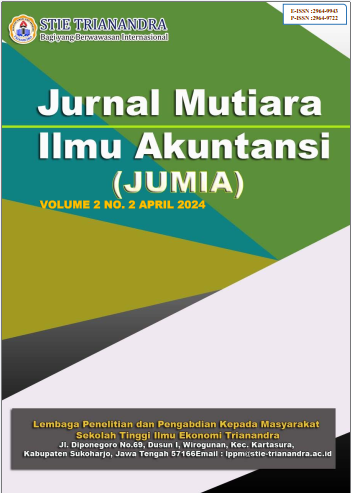Teknologi Digital Dan Transformasi Internal Audit Terhadap Perlakuan Laporan Keuangan : Studi Literatur
DOI:
https://doi.org/10.55606/jumia.v2i2.2596Keywords:
Digital Technology, Internal Audit Transformation, Treatment of Financial Reports, Internal Audit Process Efficiency.Abstract
This article discusses the impact of digital technology on the transformation of internal audit and its implications for the treatment of financial reports. As technology advances, companies are adopting digital solutions to improve the efficiency and effectiveness of their internal audit processes. This transformation not only includes the use of new tools and technologies, but also changes the paradigm and methodology of internal audit work. Digital technology provides greater capabilities in collecting, analyzing and understanding data in real-time. Internal audit can leverage advanced analytics technology, artificial intelligence, and natural language processing to identify risks, detect anomalies, and provide deeper insights into a company's finances. With the adoption of digital technology, internal audit transformation can increase audit accuracy and thoroughness, reduce the risk of human error, and enable fraud identification more effectively. In addition, technology also facilitates the implementation of more proactive and adaptive risk-based audit practices, allowing internal audit to focus on the most critical areas and provide significant added value. However, this transformation also brings new challenges, including the need to develop new skills among auditors, manage information security risks, and ensure compliance with regulations related to data privacy and security. This article details effective implementation strategies, as well as providing views on how organizations can optimize the potential of digital technology to improve the quality of financial reporting treatment. Thus, this article aims to provide in-depth insight into the role of digital technology in the transformation of internal audit and its impact on the treatment of financial statements, identify the associated benefits and challenges, and provide guidance for companies wishing to adopt such technology effectively.
References
Adi Putra, P. N., Estiyanti, N. M., & Eka Putra, I. J. (2022, Januari 14). Audit Tata Kelola Sistem Informasi Menggunakan Framework COBIT 5 Studi Kasus Pada LPD Desa Temesi. Retrieved Desember 20, 2023
Akashi, T., & H, B. (n.d.). Analisis Faktor Faktor Penerimaan Apliaksi Sistem Audit Audit Tool and Linked Archive System (ATLAS) (Studi Empiris pada Kantor Akuntansi Publik di Jawa Timur). Retrieved 12 21, 2023
Anwar, A. S. (n.d.). Peran Auditor Teknologi Informasi Dalam Mengurangi Kejahatan Komputer. Retrieved Desember 22, 2023
Dzikron, M. D. (n.d.). Pengaruh E-Audit dan Kompetensi Auditor terhadap Kualitas Audit. Jurnal Riset Akuntansi. Retrieved Desember 23, 2023
Elisabeth, D. M. (2019, April). Kajian Terhadap Peranan Teknologi Informasi Dalam Perkembangan Auidt Komputerisasi (Studi Kajian Teoritis). Jurnal Manajemen Informatika & Komputerisasi Akuntansi, Vol 3 No 1. Retrieved Desemeber 25, 2023
Hanifah, M. N., & Pramudyastuti, O. L. (2021, Desember). Analisis Efektivitas Audit Tool and Linked Archive System Dalam Menunjang Proses Audit Laporan Keuangan. Jurnal Maneksi, Vol 10 No 2 Desember. Retrieved Desember 25, 2023
Ismanidar, N., Salman, M., & Ridha, A. (2023, Desemeber 2). Pengaruh Dukungan Remote Audit Terhadap Kualitas Audit melalui Teknologi Informasi di Era Teknologi 4.0 dan Masyarkat 5.0. Jurnal Penelitian Ekonomi Akuntansi, Vol 7 No 2. Retrieved 12 27, 2023
Kristanto, D. (2008). Revolusi Teknologi Informasi dan Pengaruhnya Terhadap Perkembangan SIM Bagi Auditor. Jurnal Akuntansi dan Sistem Teknologi Informasi, Vol 6 No 1 April 2008. Retrieved Desember 20, 2023
Kurniawan, A. (n.d.). Pengaruh Kualitas Audit Pada Kualitas Informasi Terhadap Laporan Keuangan. Retrieved Desemeber 20, 2023
Nugraha, A., & Laksito, H. (2014). Antesenden Penerimaan Teknologi Informasi Dalam Profesi Audit Internal Dengan Menggunakan Technology Accepteance Model (Studi Kasus pada Bank Perkreditan Rakya di Jawa Tengah). Diponegoro Journal Accounting, Volume 3 No 2, 1-15. Retrieved 12 24, 2023
Putri, M. D., & Triandi. (2020). Pengaruh Audit Internal Terhadap Kualitas Laporan Keuangan Studi Kasus pada PT Damar Bandha Jaya Corp. Bogor. Jurnal Ilmiah Akuntansi Kesatuan, Vol 8 No 1. Retrieved Desember 32, 2023
Setiawan, I., Amajadallah, A. A., & Budi, W. A. (2022, Agustsus). Penerapan Aplikasi ATLAS, Kompetensi dan Independesni Auditor Serta Kualitas Audit Kantor Akuntan Publik di Semarang. Journal of Accounting and Finance, Vol 1 No 1. Retrieved 12 15, 2023
Wulandari, D. M., Ummah, I. C., Kusnul Khotimah, & Nis, K. K. (2023, 2). Dampak Teknologi Informasi Terhadap Efisiensi dan Efektivitas Proses Audit. Jurnal Ekonomi, Manajemen dan Akuntansi. Retrieved Desember 25, 2023











